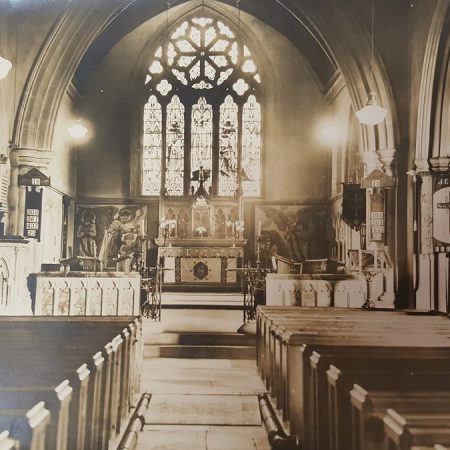A tiny scrap of paper in a filing cabinet in a church hall has solved a mystery that has long puzzled local people. Behind the altar of Peartree Church, Southampton, are two frescoes that were until recently unattributed. Now, not only is the artist known but also the year in which they were painted.
HAT trustee and historian Dr Cheryl Baker who made the discovery, said: “We suspected it was of the Pre-Raphaelite school, but we had no idea who’d painted them, or why or when. We now know that it was in1910 by Andrew Donaldson who lived at Lyndhurst and is in the reference books. This is very exciting as we are currently working on a new book on the history of the church as part of the 400th anniversary celebrations being held later in the year.”
A programme of events between May and September includes a wide range of activities –a local history fair, theatre, nature trails, concerts, and much more. It will showcase this part of the city, once called Itchen Ferry.
In about 1600 Francis Mylles, tenant of the bishop of Winchester at Bitterne Manor and Winchester MP, built Peartree House. He used some of the stone from the Roman port at Bitterne (Clausentum). It was a grand mansion that went to his daughter and then, after her death, to her husband, Captain Richard Smith. At the time local people wanting to go to church had to be rowed across the river to St Mary’s in all weathers. Smith decided it was time build a small church on Peartree Green. It was a chapel-of-ease to the mother church and formally called the Jesus Chapel of St Mary Extra.
In September, 1620–only a month after the Mayflower had left for the New world– the church was consecrated by the bishop of Winchester, Lancelot Andrewes. It is surprising that he came, as he was an old man at the end of his career, having already served as bishop of Chichester and Ely. He spent most of his time in Winchester Palace in London, as the diocese then stretched to Southwark(ODNB)
However, this was no ordinary event, as Peartree was the first church to be consecrated since Henry VIII had broken with Rome in 1534. All places of worship consecrated before that were Roman Catholic. Hence the bishop had to write a new, Protestant service, especially for Peartree. It is still used to this day by the Anglican church [6.4.2.23a1].
There is a local tradition that Thomas Gray wrote his Elegy, or obtained inspiration for it at Peartree Green, but there seems to be no evidence for this in standard works. The old pear tree which still stands on the green, itself a remnant of Ridgeway Heath, is said to have been planted by Elizabeth I, perhaps en route to the Earl of Southampton at Titchfield.
Commenting on the locality, Dr Butler said: “In the late 18th/early 19th centuries the area flourished as a seaside resort, with elegant villas, and people rich from the East India Company. The church was extended and provided with box-pews. Later came the floating ferry and the area was industrialised by boatbuilders and Supermarine at Woolston.
“The paintings in the church are a sign of a different age. They commemorate George Henry Stone, who doesn’t seem to be well known, but at the time Peartree Green was quite an arty place. The church used to have a Burne-Jones window– sadly destroyed by bombing in the last war. It was made by Morris & Co and William Morris’s brother, Hugh, lived at Peartree House.
“Also there were painters and sculptors in the Thornycroft family – in June 1904 Sir Isaac Thorncroft and his son John Edward had bought the shipyard of Mordey Carney & Co at Woolston and brought down their business from Chelsea. This is the origin of Vosper Thorncroft, now owned by the VT Group in the USA. ”
For more information on Celebrating 400 Years of Peartree Church, click here: [6.4.2.23a2]
-

Detail of one of the frescoes by Donaldson -

Interior of Peartree Church, 1922, showing the frescoes in the chancel -

The original form of Peartree Church, bnefore enlargments, in 1822 and 1846-7 -

Peartree Church, after enlargement, c 1850, by Philip Brannon -

View from Itchen Ferry, looking towards the port of Southampton and the Isle of Wight, with a view of the floating ferry, Philip Brannon, c. 1850 -

Programme of events for Celebrating 400 Years of Peartree Church, 2020

